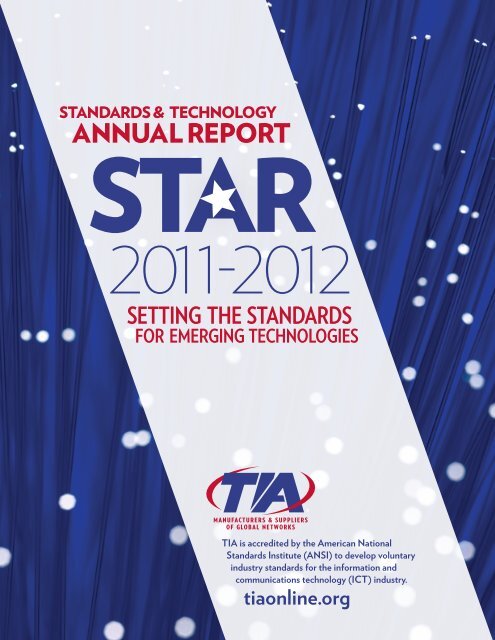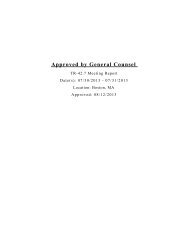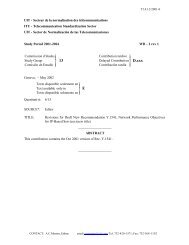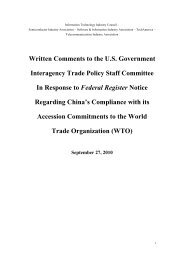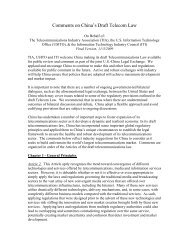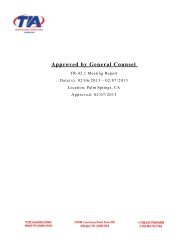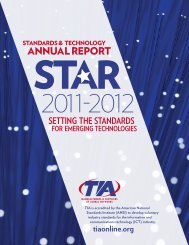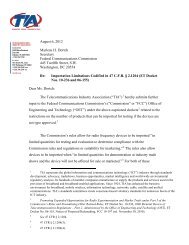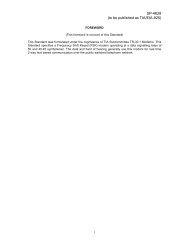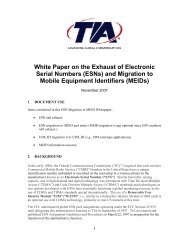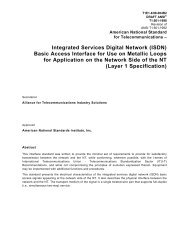annual report - Telecommunications Industry Association
annual report - Telecommunications Industry Association
annual report - Telecommunications Industry Association
- No tags were found...
Create successful ePaper yourself
Turn your PDF publications into a flip-book with our unique Google optimized e-Paper software.
Standards & TechnologyAnnual <strong>report</strong>STAR2011-2012Setting the Standardsfor Emerging TechnologiesTIA is accredited by the American NationalStandards Institute (ANSI) to develop voluntaryindustry standards for the information andcommunications technology (ICT) industry.tiaonline.org
TIA STAFFLeadershipGrant SeiffertPresident+1.703.907.7701gseiffert@tiaonline.orgAndrew KurtzmanVice President &Corporate Counsel+1.703.907.7413akurtzman@tiaonline.orgMary Piper WatersSr. Director, Operations+1.703.907.7701mwaters@tiaonline.orgTechnology andStandardsCheryl BlumVice President, Technology& Standards Development+1.703.907.7436cblum@tiaonline.orgHerb V. Congdon II, PEAssociate Vice President+1.703.907.7703hcongdon@tiaonline.orgJohn DerrDirector, Technical Programs+1.703.907.7791jderr@tiaonline.orgGeorge IvanovManager, Technology Initiatives+1.703.907.7702givanov@tiaonline.orgTeesha JenkinsCommittee ManagementSpecialist+1.703.907.7706tjenkins@tiaonline.orgMarianna KramarikovaManager, Technology& Standards+1.703.907.7743mkramarikova@tiaonline.orgMatt LanghanManager, Standards InternetDevelopment+1.703.907.7482mlanghan@tiaonline.orgRonda MarrowCommittee ManagementSpecialist+1.703.907.7974rmarrow@tiaonline.orgVictoria MitchellDirector, 3GPP2+1.703.907.7779vmitchell@tiaonline.orgStephanie MontgomerySr. Director, StandardsCommunications+1.703.907.7735smontgomery@tiaonline.orgFlorence OtienoSr. Manager, InternationalStandards Programs+1.703.907.7556fotieno@tiaonline.orgGermaine PalangdaoManager, StandardsDevelopment & Programs+1.703.907.7497gpalangdao@tiaonline.orgJeffrey WestSr. Manager, InternetDevelopment/3GPP2+1.703.907.7730jwest@tiaonline.orgGovernmentAffairsDanielle CoffeyVice President & GeneralCounsel, Government Affairs+1.202.346.3243dcoffey@tiaonline.orgJoseph AndersenDirector, Technology &Innovation Policy+1.202.346.3249jandersen@tiaonline.orgNick FetchkoDirector, International &Government Affairs+1.202.346.3246nfetchko@tiaonline.orgBrian ScarpelliManager, Government Affairs+1.202.346.3251bscarpelli@tiaonline.orgDileep SrihariDirector, Legislative &Government Affairs+1.202.346.3248dsrihari@tiaonline.orgMark UncapherDirector, Regulatory &Government Affairs+1.202.346.3244muncapher@tiaonline.orgSustainability,Networking ANDIntelligenceTaly WalshVice President,Networking & Intelligence+1.703.907.7744twalsh@tiaonline.orgMichelle MelsopManager, TIA Events+1.703.907.7002mmelsop@tiaonline.orgMarketing,Membership andBusinessDevelopmentJohn JacobsSr. Vice President,Membership, Marketing &Business Development+1.703.907.7747jjacobs@tiaonline.orgAncilla BradyDirector, MemberRelations & Services+1.703.907.7713abrady@tiaonline.orgEileen BramletVice President, Marketing &Communications+1.703.907.7749ebramlet@tiaonline.orgLanis CotterDirector, MemberDevelopment & Sales+1.703.907.7005lcotter@tiaonline.orgBruce DegnDirector, MemberDevelopment & Sales+1.703.907.7000bdegn@tiaonline.orgJeff HannahManager, BusinessDevelopment+1.703.907.7582jhannah@tiaonline.orgClaire JohnsonProduction Associate+1.703.907.7742cjohnson@tiaonline.orgPhilip LucaManager, Marketing &Communications+1.703.907.7719pluca@tiaonline.orgAbe NejadICT Journalist/Anchor,TIA NOW+1.703.907.7004anejad@tiaonline.orgKevin O’ConnorManager, BusinessDevelopment+1.703.907.7007koconnor@tiaonline.orgLois ParksManager, Member Relations+1.703.907.7739lparks@tiaonline.orgDave PeisachManaging Director, Sales &Business Development+1.703.907.7003dpeisach@tiaonline.orgMike SnyderDirector, PR & Communications+1.703.907.7723msnyder@tiaonline.orgFlorence SumarayDirector, Marketing+1.703.907.7471fsumaray@tiaonline.orgBrian WestDirector, Interactive Media+1.703.907.-7493bwest@tiaonline.orgOperationsBisrat BainesagnSr. Network Manager+1.703.907.7718bbainesagn@tiaonline.orgLida BerlejungController+1.703.907.7720lberlejung@tiaonline.orgLisa MaghraouiDirector, Human Resources+1.703.907.7716lmaghraoui@tiaonline.orgTuan NguyenSr. Web Developer+1.703.907.7738tnguyen@tiaonline.orgTony ZarafsharSr. Manager, Information &Technology Services+1.703.907.7775tzarafshar@tiaonline.orgAbout TIAThe <strong>Telecommunications</strong> <strong>Industry</strong> <strong>Association</strong> (TIA) represents the global information and communications technology (ICT) industry through standardsdevelopment, advocacy, tradeshows, business opportunities, market intelligence and worldwide environmental regulatory analysis. Since 1924, TIA hasbeen enhancing the business environment for broadband, mobile wireless, information technology, networks, cable, satellite and unified communications.Members’ products and services empower communications in every industry and market, including healthcare, education, security, public safety, transportation,government, the military, the environment and entertainment.2011-2012 TIA Standards & Technology Annual Report
Table of ContentsMessage from the TIA LeadershipLetter from the Chairman of the Board, TIA's President,and the Technical Committee Chairmen...........................................................................3TIA Engineering Committee ReportsTR-8 Mobile and Personal Private Radio Standards..............................................................4TR-14 Point-to-Point Communications Systems......................................................................6TR-30 Multi-Media Access, Protocols and Interfaces............................................................. 7TR-34 Satellite Equipment & Systems...................................................................................8TR-41 User Premises <strong>Telecommunications</strong> Requirements.....................................................9TR-42 <strong>Telecommunications</strong> Cabling Systems........................................................................11TR-45 Mobile and Personal Communications Systems....................................................... 14Third-Generation Partnership Project (3GPP2).....................................................................17TR-47 Terrestrial and Non-TerrestrialMobile Multimedia Multicast.......................................................................................... 19TR-48 Vehicular Telematics..................................................................................................20TR-50 Smart Device Communications.................................................................................. 21TR-51 Smart Utility Networks...............................................................................................22TIA Global InvolvementISO/IEC JTC 1/SC 25 Interconnection ofInformation Technology Equipment................................................................................23IEC TC 46 Cables, Wires, Waveguides,R.F. Connectors, R.F. and Microwave Passive Components and Accessories..................24IEC TC 76 Optical Radiation Safety and Laser Equipment....................................................24IEC TC 86 Fibre Optics..........................................................................................................25TIA BOARD MEMBER companiesACS SolutionsAdtranAlcatel-LucentCisco SystemsCorning Incorporated*Dow Electrical &<strong>Telecommunications</strong>Ericsson, Inc.FAL Associates*GENBAND, Inc.Gray Beards ConsultingHenkels & McCoyILS TechnologyIntelJuniperLGEMicrosoftMotorola MobilityMotorola SolutionsNokia Siemens NetworksNumerex Corp.OneChip PhotonicsPanasonic Computer Solutions Co.QualcommSumitomo Electric Lightwave Corp.Tarana Wireless, Inc.TE ConnectivityTellabsWalker and AssociatesWirefreeCom Inc.*Advisor to the Boardtiaonline.org
TR-14 Point-to-Point Communications SystemsEngineering Committee TR-14 developsstandards that affect the design,fabrication and production of antennatowers. TR-14’s specifications allowcarriers to effectively and reliably relay communicationsvia antenna towers. TR-14.7’stask group, Structural Reliability, deals withstructural performance and reliability issuespertinent to the structures utilized in the telecommunicationsindustry. As the industry’ssupport structures continue to age, reliabilityand maintenance issues will be crucial tothe longevity of the industry’s infrastructure.top standardsTIA-222-G Series: Structural Standard for AntennaSupporting Structures and AntennasTIA-1019-A: Installation, Alteration, and Maintenanceof Antenna Supporting Structures and Antennas2012 face-to-face meetingMiami, FL: OctobertR-14 leadershipChair, TR-14Brian Reese, ReliaPOLEvice-Chair, TR-14John Erichsen, EET, LLCTR-14.7 Structural Standardsfor Steel Antenna Towers andAntenna Supporting StructuresChair: Brian Reese, ReliaPOLEVice-Chair: John Erichsen, EET, LLCThe committee is also involved in developingstandards for the minimum loadingrequirements for towers under construction,alteration or maintenance, andaddressing specialized equipment such asgin poles, frames, hoists and the temporarysupports necessary to safely completethose tasks.One of TR-14’s most popular standardsis TIA-222, Revision G, Structural Standardfor Antenna Supporting Structures andAntennas. The standard provides therequirements for structural design andfabrication of new, and modification ofexisting, structural antennas, antenna-supportingstructures, structural components,guy assemblies, insulators and foundations.The standard is referenced in theInternational Building Code and as suchhas acceptance by building officials.2011 AccomplishmentsTR-14.7 completed work on the revisionto TIA-1019, Structural Standards forSteel Gin Poles Used for Installation ofAntenna Towers and Antenna SupportingStructures. First released in 2004, theTo find out moreabout participating inTR-14, please contactMarianna Kramarikova(mkramarikova@tiaonline.org |+1.703.907.7743).Participating Organizations: 4SE, Inc., Aero Solutions, LLC, American Tower Corporation, AT&T Mobility,B&C Contracting Company, B&T Engineering, Inc., Bechtel Telecom, Bentley Systems, Inc., Black &Veatch <strong>Telecommunications</strong>, Broadcast Tower Technologies, Inc., C Faulkner Engineering, Cell Trees,Inc., CMX, Crown Castle International Corp., CSI <strong>Telecommunications</strong>, Inc., Davidson Engineering,LLC, DaVinci Engineering Inc., EET, LLC, Ehresmann Engineering, Inc., Electronics Research Inc., FALAssociates, FDH Engineering, FWT, Inc., Glen Martin Engineering, Global Tower Partners, GPD Group,Industrial Engineering & Testing, <strong>Industry</strong> Canada, ISE Incorporated, KCI Technologies, Inc., KPFFConsulting Engineers, Malouf Engineering International, MLD Engineering Solutions, Inc., MUTI, NTIA,Paul J. Ford and Company, ReliaPOLE Inspection Services Co., Rohn Products LLC, RTKL AssociatesInc., Sabre Towers & Poles, Shively Labs, Sioux Falls Tower Specialists, Stainless LLC, StealthConcealment Solutions, Inc., Tower Consultants, Inc., Tower Engineering Professionals, Inc., TowerNumerics, Inc., Tower Technology, Towerkraft Engineering, P.C., Turris Corporation, U.S. Department ofCommerce, Valmont Communications, Walker Engineering Inc., Weisman Consultants, and WesTowerCommunications Inc.standard was intended to provideminimum design criteriafor the design and use of steel gin polesfor installation of antennas and antennasupportingstructures. The standardhas been updated to provide minimumloading requirements for towers underconstruction, alteration or maintenance,and to address specialized equipmentsuch as gin poles, frames, hoists and thetemporary supports necessary to safelycomplete those tasks, along with thedesign requirements for a gin pole. Thestandard considers special constructionrequirements and processes commonlyused when removing an existing antennafrom an existing tower, or removing allor a portion of an existing tower. Therevised standard is TIA-1019-A, Standardfor Installation, Alteration and Maintenanceof Antenna Supporting Structuresand Antennas.TR-14.7 also focused efforts during thepast year on the continued developmentof a small wind turbine structure designguideline and on working in conjunctionwith the wind industry to accomplish this.Many of our member manufacturers andengineers are being requested to utilizecommunications structures for smallturbines and the generation of power.This document will be associated with TIA-222-G, due to that document’s acceptanceby building officials through the InternationalBuilding Code. As the country movesto more environmentally friendly methodsof developing energy, our communicationssupport structures will play a role in thiseffort.2012 ActivitiesThe committee continues developmentof a communications pole base platedesign supplement to be issued as anaddendum to TIA-222-G. This documentwill standardize the design approach forthis critical connection in pole structures.The committee is also continuing workon a wind tower addendum to TIA-222-G,in partnership with the American WindEnergy <strong>Association</strong>.62011-2012 TIA Standards & Technology Annual Report
TR-34 Satellite Equipment and SystemsTR-34 develops voluntary standardsrelated to satellite communicationssystems in both the space and terrestrialsegments. The committeefocuses on standards for space-borne andterrestrial hardware, interfaces on standardsfor satellite and terrestrial systems, andthe efficient use of spectrum and orbitalresources, including sharing between satelliteand terrestrial services.Among the many accomplishments ofTR-34 is the development of a suite of standards,housed within the TIA-1040 series, thatprovides an introduction to the physical-layerspecification for the SES BSM RegenerativeSatellite Mesh – A (RSM-A) air interface family.On the international front, TR-34 hascontributed to the joint standards work ofthe European <strong>Telecommunications</strong> StandardsInstitute’s (ETSI) Satellite Earth StationSystems (SES) technical committee andits Broadband Satellite Multimedia (BSM)technical committee, which resulted in thestandard on Connection Control Protocol C2Pprotocol activities.top standardsTIA-1040 Series: Regenerative SatelliteMesh Air InterfaceTIA-1073 Series: Satellite NetworkModem SystemsTIA-1008: IP Over Satellite (IPOS)TIA-1039: QoS Signaling for IP QoSSupport and Sender Authentication(IPv4 and IPv6)In addition, the TR-34 committeedeveloped TIA-1039, QoS Signaling forIP QoS Support, which defines the QoSsignaling standard for use within IPv4 andIPv6 network-layer protocols. This mechanismallows the necessary resources to beallocated to a flow (or group of flows) asthey traverse the communications network.This signaling scheme is designed to work“in-band” through an installed router,and QoS is set up in real time across thenetwork without a separate, out-of-bandsoftware signaling structure like ReservationProtocol (RSVP).2011 AccomplishmentsTR-34 began new work on a Joint IPModem (JIPM) interworking standard.The new work item is an interoperabilityspecification, consisting of extensionsto the current DVB-S2 and DVB-RCSspecifications, which are used for the U.S.Department of Defense JIPM system. Theinteroperability specification builds on2012 face-to-face meetingArlington, VA: September 20tR-34 leadershipChair, TR-34Anthony Noerpel,Hughes NetworkSystemsvice-chair,TR-34Lars Erup, iDirectParticipating Organizations: HughesNetwork Systems, iDirect, AASKITechnology Inc., and ViaSatTo find out more about participatingin TR-34, please contact GeorgeIvanov (givanov@tiaonline.org |+1.703.907.7702).the requirements detailed in the SatelliteNetwork Modem Standard set of requirementspublished as the TIA/EIA-1073 setof documents. TR-34 also continued aliaison relationship with the ETSI DigitialVideo Broadcasting Satellite group.2012 ActivitiesIn 2012, TR-34 is planning to begin workon Joint IP Modem standards, publishTIA-1008-B, IP Over Satellite, and plans toassess how its IP standards integrate withthe smart grid work of TR-51.The committee also intends tocontinue its liaison relationships with DVBand ETSI to facilitate global interoperabilityfor its standards.82011-2012 TIA Standards & Technology Annual Report
TR-41 User Premises <strong>Telecommunications</strong> RequirementsSince 1976, Engineering CommitteeTR-41 has been developing voluntarystandards for wireline terminal equipmentand systems, including thosethat may use a radio link between a remoteterminal and a base station or gateway unit,to provide voice services, integrated voiceand data services, and Internet protocol (IP)applications. With its three subcommitteesand their working groups, the committeedevelops performance and interface criteriato ensure proper interworking of equipmentand systems with each other, public networks,carrier-provided private-line services,and IP telephony infrastructures.In addition, TR-41 develops criteria forpreventing harm to the telephone network,which become mandatory when adopted bythe Administrative Council for TerminalAttachments (ACTA). It is also engaged in providinginput on product safety issues, identifyingenvironmental considerations for userpremises equipment and addressing theadministrative aspects of product approvalprocesses.The FCC established a PBX AdvisoryCommittee to provide industry input onthe development of Part 68 network harmscriteria in the early 1970s. Once thatwork was complete, committee memberscontinued meeting to discuss performanceand interoperability requirements underthe auspices of the Electronic IndustriesAlliance (EIA) as its 41st Engineering Committee.Among TR-41’s first standards wereEIA-464 on PBXs, EIA-470 on telephonesand EIA-504 on hearing aid compatibility.The scope of its work later expanded toinclude equipment with digital interfaces,products that use wireless links betweenthe user interface unit and a base stationor gateway unit, and IP applications.When the FCC deregulated connectionto the public switched network in 2000,TR-41 transformed the Part 68 rules into theTIA-968 Network Harms Criteria standardand companion documents, which becomemandatory requirements for terminal equipmentafter they are adopted by ACTA.2011 AccomplishmentsTR-41, with its three subcommittees andtheir various working groups, had an activeyear, with three new standards and revisionsof six existing documents approvedfor publication. It also reaffirmed thecontinuing status of five other documents.Projects were launched for the fast-trackdevelopment of two new standards, andwork began or continued on revisions oraddendums for six existing documents.The committee worked on two additionsto the ANSI/TIA-470 series of analoginterface telephone standards. ANSI/TIA-470.120-C, Transmission Requirementsfor Analog Speakerphones, was publishedin February. ANSI/TIA-470.330-C, DigitalTelephone Answering Device PerformanceRequirements, was approved for publicationin November and will be availablein early 2012. Both standards carry the“C” designation, even though they arecompletely new documents, because thetop standardsTIA-470 Series: Performance Requirementsfor Analog TelephonesTIA-920 Series: Transmission Requirementsfor Wideband Digital Wireline TelephonesTIA-968-B: Technical Requirements forConnection of Terminal Equipment to theTelephone NetworkTIA-1083-A: Handset Magnetic MeasurementProcedures and Performance Requirements“C” revision wasthe first time the470 standard hasbeen broken intosubdocuments.These standardsseek to improvethe performanceof speakerphonesandTIA-1083phone answeringmachines forconsumers.The committee has also split theCompatible withHearing Aid T-CoilTIA-920 standard on wideband (150 to6800 Hz) digital transmission performanceinto subdocuments for the “A” revision.TIA-920.000-A, Overview of AcousticRequirements for Wideband DigitalWireline Telephones, and its correspondingTIA-920.110-A handset and TIA-920.130-Aheadset subdocuments were publishedin February. Work on the TIA-920.120-Aspeakerphone subdocument has nowprogressed through an initial ballot. Anaddendum for the TIA-920.130-A headsetstandard to add requirements for binauralheadsets has also been initiated.The revised ANSI/TIA-855-A, Stutter DialTone Detection Device Performance Requirements,was published in June 2011, andprogress was made on ANSI/TIA-470.110-D,Handset Acoustic Performance Requirementsfor Analog Terminals. ANSI/TIA-470.220-D,Alerter Acoustic Output Performance Requirementsfor Analog Telephones, and ANSI/TIA-1063-A, Analog Telephone Port Requirementsfor Packet-Based User PremisesTerminal Adapters, were initiated.TTIA-1083 Compliance logotiaonline.org9
TR-41 User Premises <strong>Telecommunications</strong> Requirements2012 face-to-face meetingsSan Antonio, TX: February 27-March 2Dallas, TX: June 4-8Las Vegas, NV: November 5-9In the area of environmental and safetyconsiderations, the committee brought itsexpertise on lightning surges to bear in theSmart Grid arena and published ANSI/TIA-1194, Surge Resistibility of Smart Grid EquipmentConnected to either DC or 120/240 VSingle Phase AC and Metallic CommunicationsLines, in November. It also publisheda revised ANSI/TIA-631-B, Radio FrequencyImmunity Requirements, in February.Lastly, the committee’s continuingefforts in technical and administrative regulatoryconsiderations saw the publicationof a major revision of its Part 68 suggestedtest procedures document, TSB-31-D,Rationale and Measurement Guidelinesfor U.S. Network Protection, to align it withthe restructured and previously publishedANSI/TIA-968-B, Technical Requirements forConnection of Terminal Equipment to theTelephone Network. It is also updating thePart 68 FAQ list on the TR-41 web page toreference the restructured document. Thecommittee has initiated a project for thefirst addendum to ANSI/TIA-968-B.2012 ActivitiesThe committee expects to complete thefast-track development of two new standards.ANSI/TIA-4953, Amplified TelephoneMeasurement Procedures and PerformanceRequirements, will address high receive gaintelephones used by hard of hearing people.ANSI/TIA-4965, Receive Volume ControlRequirements for Digital and Analog WirelineTelephones, is intended for referenceby the FCC and <strong>Industry</strong> Canada for volumecontrol requirements in their respective Part68 and CS-03 regulations. Both documentswill make use of a new, easily understoodvolume control measure called “ConversationalGain” which defines how loud thereceive level is compared to a face-to-faceconversation at a distance of one meter.Another major project anticipated forkickoff in 2012 is a “B” revision of the TIA-20151050VOIP Spending in the United States ($ Billions)0.30.82.03.85.92003 2004 2005 2006 2007 2008 2009 2010 2011 2012 2013 2014 2015Source: TIA’s 2012 ICT Market Review and Forecast920 series of wideband digital transmissionstandards, to include terminology and testprocedures more commonly used in unifiedcommunications and other non-traditionaltelephony applications. Consideration willbe given to also including the narrowbandrequirements found in ANSI/TIA-810-B,Transmission Requirements for NarrowbandDigital Telephones.The committee will continue to monitordevelopment of the international hazardbasedsafety standard IEC 62368-1, Audio/video, information and communicationtechnology equipment – Part 1: Safetyrequirements, and provide input to theTechnical Harmonization Committee forits UL/CSA counterpart. Lastly, the groupexpects to launch a project to create anaddendum to TSB-31-D covering measurementprocedures for Conversational Gainin anticipation of the FCC referencing thenew ANSI/TIA-4965 standard for specifyingreceive volume control.7.89.411.713.214.6TR-41 LeadershipChair, TR-41Stephen R. Whitesell,Whitesell ConsultingTR-41.3 Analog & DigitalWireline TerminalsChair: James Bress, ASTTechnology Labs, Inc.16.017.418.9TR-41.7 Environmentaland SafetyConsiderationsChair: Randy Ivans,Underwriters LaboratoriesTR-41.9 Technicaland AdministrativeRegulatoryConsiderationsChair: VacantParticipating Organizations: AST Technology Labs,Audio Precision, Broadcom Corporation, CiscoSystems, Inc., Hewlett-Packard, <strong>Industry</strong> Canada,Littelfuse, Microsoft, Plantronics, UnderwritersLaboratories, Uniden America Corporation, VerizonCommunications, and Whitesell Consulting.To find out more about participating inTR-41, please contact Marianna Kramarikova(mkramarikova@tiaonline.org | +1.703.907.7743).102011-2012 TIA Standards & Technology Annual Report
TR-42 <strong>Telecommunications</strong> Cabling SystemsEngineering Committee TR-42 isresponsible for developing andmaintaining voluntary standards fortelecommunications cabling andinfrastructure in user-owned buildings suchas commercial buildings, residential buildings,homes, data centers, industrial buildingsand now healthcare facilities, as wellas all applications of fiber optic cable andcabling systems. The committee’s standardscover requirements for network architecture,copper and optical fiber cabling components(such as cables, connectors and cableassemblies), installation and field testing,in addition to premises administration,pathways, spaces, grounding and bondingto support the cabling.2011 AccomplishmentsIn 2011, TR-42 was aligning its suite ofstandards with ANSI/TIA-568-C.0, Generic<strong>Telecommunications</strong> Cabling for CustomerPremises. Each of the premises standardswill have allowances and exceptions toTIA-568-C.0. For example, the TIA-1005standard on Industrial infrastructure hasbeen revised with exceptions and allowancesbased on ANSI/TIA-568-C.0 andTIA-569-C for pathways and spaces. Plansare also beginning on the development ofthe ANSI/TIA-568-D Series. Next-generationbalanced twisted-pair cabling is beingpursued for higher bandwidth structuredcabling solutions that go beyond 10 Gigabitsper second. Optical fiber standardsare also being built to address the functionof the newly developed bend-insensitiveoptical fiber.In the area of generic telecommunicationscabling and premise cabling, thecommittee published ANSI/TIA-862-A,top standardsTIA-942 Series: <strong>Telecommunications</strong>Infrastructure Standards for Data CentersTIA-568 Series: Commercial Building<strong>Telecommunications</strong> Cabling StandardsTIA-569 Series: Commercial BuildingStandards for <strong>Telecommunications</strong> Pathwaysand SpacesANSI/TIA-455 Series: Standards for FiberOptic Test Proceduresa revision of the Building AutomationCabling Standard for Commercial Buildings,ANSI/TIA-568-C.1-1 Commercial Building<strong>Telecommunications</strong> Cabling StandardAddendum 1 – Pathways and Spaces, andANSI/TIA-568-C.1-2 Commercial Building<strong>Telecommunications</strong> Cabling StandardAddendum 2 – General Updates. It alsocompleted the development of ANSI/TIA-570-C, Residential TelecommunicationInfrastructure Standard, which will bepublished in early 2012.TR-42 completed and published ANSI/TIA-569-C, <strong>Telecommunications</strong> Pathwaysand Spaces. The subcommittee also completeddevelopment of ANSI/TIA-568-C.1-1,Commercial Building <strong>Telecommunications</strong>Cabling Standard, Addendum 1 Pathwayand Spaces, which contains additionalrequirements, exceptions and allowancesto TIA-569-C relevant to pathways andspaces in commercial buildings. Thisdocument was approved for publicationby TR-42.3 and TR-42.1. The subcommitteebegan work on ANSI/TIA-569-C-1, anaddendum to extend the allowable HVACenvelope for telecommunications spacesin harmonization with the latest ASHRAEguidelines. Publication is expected in2012.In support of Customer-OwnedOutside Plant <strong>Telecommunications</strong>Infrastructure, the committee publishedANSI/TIA-758-B, Customer-Owned OutsidePlant <strong>Telecommunications</strong> Infrastructure.The revised standard includes additionalguidelines for the physical location andprotection of below-ground cable plant, arevision of the references to the appropri-tiaonline.org11
TR-42 <strong>Telecommunications</strong> Cabling Systems2012 face-to-face meetingDallas, TX: June 4-8West Palm Beach, FL: February 7-10Philadelphia, PA: October 1-5ate standards and a revision of the annexreferring to cabling lengths for specificapplications in ANSI/TIA-568-C.0. Since TR42.4 has achieved its goal of publishing anew revision of the OSP Cabling Standard,the subcommittee was placed in dormantstatus pending any other action items.ANSI/TIA-606-B is near completion,which incorporates TIA-606-A-1, AdministrationStandard for Commercial <strong>Telecommunications</strong>Infrastructure Addendum 1– Administration of Equipment Rooms andData Center Computer Rooms, harmonizeswith the recently published ISO/IEC TR14763-2-1 – Generic cabling – Implementationand operation of customer premisescabling – Identifiers within administrationsystems, and is backward-compatible withANSI/TIA-606-A. A key objective of thiseffort is to broaden the scope of ANSI/TIA-606-A so it will become a commonstandard for cabling administration.TR-42 is also continuing to develophigh-frequency copper twisted-pair cablingand component specifications and stateof-the-artmeasurement methods. Ofgreatest interest is a new project, BalancedTwisted-Pair <strong>Telecommunications</strong> Cablingand Components Standard, Addendum 1:Specifications for 100Ω Next GenerationCabling, which will address cabling to supportfuture applications beyond 10GBASE T.Four task groups were created to addressNext-Generation Cabling specifications:“Application Space,” “Capacity,” “Connectors”and “Cable.” TR-42 has enlistedmembers of IEEE 802.3 to help definecabling parameters.TR-42 is also in the final stages of ballotingthe proposed TIA-1183, Test Fixturesfor Balun-less Measurements of BalancedComponents and Systems, standard, whichspecifies test methods and fixtures formeasurements to 1,000 MHz. The TIA-1183Test Fixtures Task Group is investigatingexpanding the bandwidth of measurementsto at least 2.0 GHz. The BalanceTask Group has created a comprehensivemodel describing the complex couplingmechanisms contributing to alien crosstalkbetween category 6A channels, and theresultant interactions and estimated channeleffects are anticipated to be publishedas TIA TSB-1197.Publication of ANSI/TIA-1005-A, <strong>Telecommunications</strong>Infrastructure Standardfor Industrial Premises, was approved atthe October 2011 meeting. Publication isexpected in early spring of 2012. ANSI/TIA-1005-A is based on the restructuringof ANSI/TIA-1005 to harmonize with theANSI/TIA-568-C series and ANSI/TIA-569-C.In addition, task groups are being formedto define noise testing for E2/E3 for 1Gcabling and end-to-end link definition.TR-42 also completed the first addendumto ANSI/TIA-568-C.3, Optical FiberCabling Components Standard – Addendum1, Addition of OM4 Cabled OpticalFiber and Array Connectivity. TR-42.11 isworking on a round robin for encircled fluxmeasurements and also on evaluatingsystem loss budget calculations and theireffect on applications.The committee also continued todevelop projects related to fiber optictest procedures (FOTPs), fiber specificationsand cable specifications. Severaldocuments were finalized, includingTIA-455, the test procedures root standard;FOTP-244, evaluation of stored fiber tubes,intended to support the RUS outdoor cablespecifications; FOTP-122, PMD measurement;and TIA-472G000, a sewer cablestandard. The subcommittee continues inthe lead internationally in developmentof specifications and test methods forhigh-performance, bend-insensitive opticalfibers. TR-42 is also working with ICEA oncabling for multi-dwelling units (MDUs),a significant emerging segment of FTTXtopologies.TR-42 also continued working on specificationsthat give guidance on evaluating theperformance parameters of passive opticaldevices and the operation and calibrationof fiber optic measurement equipment andcompleted ANSI/TIA-607-B, Generic <strong>Telecommunications</strong>Bonding and Grounding(Earthing) for Customer Premises, and it waspublished in September 2011.2012 ActivitiesThe committee is near completion of ANSI/TIA-568-C.0-2, Generic <strong>Telecommunications</strong>Cabling for Customer Premises – Addendum2 – General Updates, and ANSI/TIA-942-A, a revision of the Telecommu-122011-2012 TIA Standards & Technology Annual Report
TR-42 <strong>Telecommunications</strong> Cabling Systemsnications Infrastructure Standard for DataCenters. TR-42 initiated a project for a newstandard to be published as ANSI/TIA-4966, <strong>Telecommunications</strong> InfrastructureStandard for Educational Buildings andSpaces.In terms of optical cabling, TR-42 isworking on a round robin for encircled fluxmeasurements and also on evaluatingsystem loss budget calculations and itsaffect on applications.In 2012, TR-42 expects to publish anew guideline document describing theeffective use of adhesive materials. Wealso expect to work on defining a processof testing adhesive materials. With theadvent of the Encircled Flux launch conditionsfor multimode fiber, documents thatcurrently make reference to older methodswill need to be reviewed and revised toeffectively incorporate these new launchconditions. Also in 2012, we will begin tolook at new technologies where opticaldevices have begun to incorporate bendinsensitiveoptical fiber and OM4 fiber.Lastly, TIA-607-1, which will describe inmore detail ground and soil resistivity testing,as well as grounding electrode systemdesign, is expected to be completed by thefall of 2012.TIA’s Fiber OpticsLAN Section (FOLS)TIA’s Fiber Optics LAN Section (FOLS)is the industry’s premier forum forpremises networking companies todiscuss industry issues and growthe market for fiber optic solutions.Formed in 1994, FOLS is a consortiumof leading fiber optic cable, componentand electronics manufacturers thatfocuses on educating end users anddesign consultants about the technicaladvantages and affordability thatoptical transmission can bring to localarea networks and fiber-to-the-deskapplications.Participating Organizations: 3M,AFL <strong>Telecommunications</strong>/Noyes FiberSystems, Berk-Tek, CommScope,Corning, Draka Communications,Fluke Networks, General Cable, OFS,Ortronics/Legrand, Leviton, Panduit,Superior Essex, Sumitomo ElectricLightwave, and TE Connectivity.2015105Fiber Miles deployed in the united states (Millions)11.0200513.814.215.82006 2007 2008 2009 2010 2011 2012 2013 2014 2015Source: TIA’s 2012 ICT Market Review and ForecasttR-42 leadershipChair, TR-42Robert Jensen, FlukeNetworksvice-Chair, TR-42Valerie Maguire, TheSiemon CompanyTR-42.1 Generic<strong>Telecommunications</strong>Cabling and PremiseCablingChair: Ray Emplit,OBO Betterman14.2 14.4TR-42.2 Residential<strong>Telecommunications</strong>InfrastructureChair: Ray Emplit,OBO BettermanTR-42.3 CommercialBuilding<strong>Telecommunications</strong>Pathways and SpacesChair: Henry Franc,Belden NetworksDivisionTR-42.5Chair: Paul Kish,Belden NetworksDivision18.5 18.2TR-42.6<strong>Telecommunications</strong>Infrastructureand EquipmentAdministrationChair: StephenHuffaker, JPMorganChase & Co.TR-42.7<strong>Telecommunications</strong>Copper Cabling SystemsChair: SterlingVaden, Optical CableCorporationTR-42.9 Industrial<strong>Telecommunications</strong>InfrastructureChair: Brad Woodman,Molex Inc.16.816.0TR-42.11 OpticalSystemsChair: Paul Kolesar,CommScope NetworkSolutions15.4TR-42.12 Optical Fibersand CablesChair: Mike Kinard, OFSTR-42.13 PassiveOptical Devices andFiber Optic MetrologyChair: Dave Fisher,TE ConnectivityTR-42.16 Premises<strong>Telecommunications</strong>Bonding and GroundingChair: Mark Harger,Harger, Inc.Participating Organizations: AESA SA, Anixter Inc., BICSI, BTR Netcom Inc., Bel Stewart Connectors,Belden Networks Division, Berk-Tek, Broadcom Corporation, C2 Consulting, CME Consulting,CommScope Network Solutions, Corning Incorporated, DCM, DYMO (RHINO), Daikin America,Datacom Standards, Defense Supply Center of Columbus, Draka Comteq Optical Fibre, Erico, Inc.,EXFO E.O. Engineering, Etherstack, Fluke Networks, Furukawa Ind. S.A., General Cable, GreenleeTextron Inc., Harger, Inc., HellermannTyton, Hitachi Cable Manchester, Hubbell Premise Wiring, Inc.,Huber+Suhner, IDEAL Industries, <strong>Industry</strong> Canada, Intertek Testing Services, J&M Consultants, Inc.,JDSU, JPMorgan Chase & Co., KITCO Fiber Optics, Leviton, MC Communications, Megger, Molex Inc.,Naval Surface Warfare Center, Nello Corporation, Nexans — NIES, Northwest Information Services,OBO Betterman, OFS, Optical Cable Corporation, OptoTest Corp, Ortronics, Inc., PPC, Panduit,Phoenix Contact, Photon Kinetics, PCC, Quabbin Wire and Cable Co., RIT Technology, Rockwell/ODVA,Siemon Company, Sumitomo Electric Lightwave, Superior Essex, Surtec America, TE Connectivity,Telcordia Technologies, The Fiber Optic <strong>Association</strong>, Tyco Electronics, U.S. Navy, US Conect Ltd.,Underwriters Laboratories, and Wiremold Company.To find out more about participating in TR-42, please contact Marianna Kramarikova(mkramarikova@tiaonline.org | +1.703.907.7743).tiaonline.org13
TR-45 Mobile and Personal Communications SystemsEngineering Committee TR-45, establishedin 1980, develops performance,compatibility, interoperability andservice standards for mobile andpersonal communications systems. Thesestandards pertain to, but are not restrictedto, service information, wireless terminalequipment, wireless base station equipment,wireless switching office equipment, ancillaryapparatus, auxiliary applications, internetworkand intersystem operations, interfaces,and wireless packet data technologies.In 1980, Engineering Committee TR-45standardized the original analog standard,AMPS Standard TIA/EIA-553 for wirelessmobile communications systems. TR-45went on to develop the first intersystem corenetwork standard for roaming in the industry,ANSI/TIA-41, which remains in use today.Later, TR-45 created the first Cellular DigitalStandard, the TDMA Standard ANSI/TIA-136.TR-45 created the ANSI/TIA-95 in 1993, relyingupon CDMA technology, which led to thedevelopment of CDMA High Speed Data(EV-DO) and the high-speed wirelessbroadband networks of today. Altogether,these standards not only provide multipleradio interfaces but also trace the evolutionfrom circuit-switched voice, circuitswitcheddata and packet data servicesto all IP-based radio access networks,capabilities and services.2011 AccomplishmentsThe TR-45 Subcommittees and Ad-HocGroups were extremely active in 2011 inthe development of standards (most inconjunction with 3GPP2) to support intertechnologyinterworking between cdma andLTE/e-UTRAN, as well as standards related tomachine-to-machine communications, Greennetworks, Femtocell systems, LTE-eHRPDinterworking core network aspects, and continuedwork on the evolution and integrationof cdma2000 ® * packet data standards andrelated features and capabilities.Regional regulatory activities were also akey focus of the subcommittees, with ongoingwork on Lawfully Authorized ElectronicSurveillance (LAES). TR-45 continued to workin the JCMAS group with ATIS on existingand new CMAS projects. In addition,TR-45 continued to work jointly with ATISto develop a joint standard on Interferenceand Co-Existence Issues Affecting LandMobile Systems. TR-45 and its subcommitteesparticipated in the NIST SmartGrid Interoperability Panel (SGIP) PriorityAction Plan 2 (PAP2) initiative on wirelesstechnologies for smart grid, in particular,the “Guidelines for Assessing Wireless Standardsfor Smart Grid Applications” and theSGIP cataloging of standards. In addition,they worked closely with 3GPP2 TSG-C WG-3in the development of contributions to theJoint ATIS/TIA Standard on Co-Existence andInterference Issues in Land Mobile Systems.Furthermore, the committee reviewedand provided contributions pertaining tomachine-to-machine (M2M) systems as wellas cloud computing.*cdma2000 ® is a registered trademark of the<strong>Telecommunications</strong> <strong>Industry</strong> <strong>Association</strong>.top standardsTIA-41 Series: WirelessRadiotelecommunications IntersystemOperationsTIA-1138 Series: e-UTRAN (LTE) tocdma2000 Connectivity and Interworking:Air Interface SpecificationTIA/IS-95: Mobile Station/Base StationCompatibiity Standard for Wideband SpreadSpectrum Cellular SystemsSubcommitees of TR-45 submittedupdates to ITU-R Working Party 5D relativeto the IMT-2000 technologies, the TDMA-SingleCarrier (SC) Radio Interface Technology(RIT) and for the CDMA-MC RIT, respectively.TR-45, through the ESN/UIMID/MEIDAd-Hoc Group (EUMAG), continues tosupport the industry on global numberingissues related to migration to Mobile EquipmentIdentifier (MEID) and E-UIM_ID. TheEUMAG also continues to partner with otherindustry groups such as the CDMA DevelopmentGroup (CDG) in its efforts to reach outand educate companies around the worldon the critical need for migration to MEID.TR-45 groups, as in the past, wereactively involved in the preparation ofvarious presentations to address the HighInterest Subjects discussed during theGlobal Standards Collaboration (GSC) 16meeting held in October/November 2011,including IMT standardization, M2M, emergencycommunications, security and lawfulinterception, and broadband access.In 2011, the committee approvedseveral standards for publication thatrelated to radio and switching technology.These include TIA-2001.1~7-E-2, InteroperabilitySpecification (IOS) for cdma2000Access Network Interfaces, TIA-878-C-3, HighRate Packet Data (HRPD) InteroperabilitySpecification (IOS) Radio Access NetworkInterfaces with Session Control in theAccess Network, TIA-895-B, CMDA TandemFree Operation, TIA-1142-A, InteroperabilitySpecification (IOS) for Evolved High RatePacket Data (eHRPD) Radio Access NetworkInterfaces and Interworking with EnhancedUniversal Terrestrial Radio Access Network(E-UTRAN), TIA-1167-A, Interoperability Speci-142011-2012 TIA Standards & Technology Annual Report
TR-45 Mobile and Personal Communications Systems2012 face-to-face meetingsLas Vegas, NV: May 30-31Chicago, IL: September 5-6Maui, HI: December 6-7fication (IOS) for Femtocell Access Points,TIA-1878-C-3, High Rate Packet Data (HRPD)Interoperability Specification (IOS) RadioAccess Network Interfaces with SessionControl in the Packet Control Function.In the spread spectrum digital technologyindustry, the committee continuesto be the industry leader in the publicationof cdma2000 standards for ThirdGeneration (3G) and beyond. Working inconjunction with 3GPP2 TSG-C, more than50 cdma2000-related standards werepublished or approved for publication in2011. Several multi-part standards werepublished relative to the Extended CellHigh Rate Packet Data (xHRPD) Air InterfaceSpecification (TIA-1185), Enhanced Addendato the cdma2000 Spread Spectrum Systems(TIA-2000-E), and cdma2000 High RatePacket Data Air Interface Specification (TIA-856-C.) Interworking and interoperabilitystandards published included E-UTRAN –cdma2000 1x Connectivity and InterworkingAir Interface Specifications (TIA-1184-1), andInteroperability Specifications for cdma2000Air Interface (TIA-1036-B). The E-UTRAN– cdma2000 HRPD Connectivity andInterworking Air Interface Specification (TIA-1138-A) was published. This specificationshould provide general users and serviceproviders with improved continuity of servicewhen switching between technologies.Other key standards published in 2011included BCMCS Codecs and TransportProtocols (TIA-1077), cdma2000 Applicationon UICC for Spread Spectrum Systems(TIA-1080-B-1), IP Based Over-the-Air DeviceManagement (IOTA-DM) for cdma2000Systems (TIA-1059-1), TTY/TDD MinimumPerformance Specification (TIA-889-B),Guidelines for using cdma2000 1x RevisionE Features on Earlier Revisions (TIA-1193-1),and Removable User Identity Module forSpread Spectrum Systems (TIA-820-D).TR-45 also develops the standards forCore Network operations and is focused ondeveloping performance, compatibility andinteroperability standards for equipmentsupporting wireless packet data for systemsthat are impacted by public, non-publicor residential mobile communications. Inaddition, it develops circuit-switched, packetdata and multimedia core network standards.These standards pertain to servicedefinition and network interface standardsfor support of interoperability and intersystemoperations, for interfaces betweenthose network elements that comprise theinfrastructure, and in support of seamlessservice to wireless subscribers. They alsodevelop standards pertaining to regionalregulatory capabilities. The committeecontinues to work closely with 3GPP2 TSG-Xand 3GPP2 TSG-S to convert specificationsdeveloped in 3GPP2 into TIA standards.In 2011, more than a dozen standardswere approved for publication. Key amongthese were several femtocell system-relatedstandards, including cdma2000 FemtocellNetwork (TIA-1165-A), Femtocell ConfigurationParameters (TIA-1188), and FemtocellSystems Overview for cdma2000 WirelessCommunication Systems (TSB-1213). Relativeto the JCMAS work with ATIS, the Joint ATIS/TIA CMAS Federal Alert Gateway to CMSPGateway Interface Specification (J-STD-101-1)was approved for publication.Other key standards published includedthe E-UTRAN – eHRPD Connectivity andInterworking: Core Network Aspects (TIA-1163-A), cdma2000 SMS/IM Interworking(TIA-1189), Accounting HA/LMA for cdma2000(TIA-4952), and Broadcast Multicast Service incdma2000 Wireless IP Network (TIA-1041-A-1).In the area of lawful intercept, thegroup is currently developing a draft documentto consider a cdma2000 FemtocellLawful Interception Implementation Guide.It worked on a joint project with ATIS WTSCand ATIS PTSC for Addendum 3 of J-STD-025-B, which allows a carrier to deliverto LEA the full BSID for location, whenauthorized, on cdma2000 packet dataintercepts, which was jointly approved forpublication in 2011. The committee continuedto develop drafts of procedures andconduct reviews of requirements related tosecurity- and authentication-related topicsand issues. During 2011, it published theFemtocell Security Framework Revision A asTIA-1169-A and Advanced Security Frameworkfor (e)HRPD as TIA-1208.The committee continues to supportTIA and partnering organizations onglobal numbering issues and administrativeinitiatives and provides recommen-tiaonline.org15
TR-45 Mobile and Personal Communications SystemsChair, TR-45Jane Brownley,Alcatel-Lucentdations on numbering topics of concernto the industry, including ElectronicSerial Number (ESN) reclamation/reuseand the migration from ESN andUser Identification Module ID (UIMID) toMobile Equipment Identity (MEID) andExtended-User Identification ModuleVice-Chair, TR-45Mark Lipford,Sprint NextelTR-45.3 Time DivisionDigital TechnologyChair: PeterMusgrove, AT&TVice-Chair: JimRagsdale, EricssonTR-45.4 Radio toSwitching TechnologyChair: David Ott,QualcommVice-Chair: ShahabSayeedi, MotorolaSolutionsID (E-UIMID). MEID global hexadecimaladministration, UIM ID administrationand ESN administration are supportedunder the direction of the EUMAG.The committee and TIA continue toreach out and work closely with relatedindustry fora. They sustain a workingManufacturer wireless device sales in the united States ($ Billions)3530252015105013.6717.44tR-45 leadership21.0222.7223.962005 2006 2007 2008 2009 2010 2011 2012 2013 2014 2015Source: TIA’s 2012 ICT Market Review and Forecast25.26TR-45.5 SpreadSpectrum DigitalTechnologyChair: Orlett Pearson,Alcatel-LucentVice-Chair: Ke-chi Jang,EricssonTR-45.8 Core NetworksChair: Betsy Covell,Alcatel-LucentVice-Chair: MarvinBienn, EricssonAd-Hoc AuthenticationGroupChair: Frank Quick,QualcommVice-Chair:Simon Mizikovsky,Alcatel-LucentAd-Hoc on ElectronicMedia DocumentationChair: Peter Nurse,Sigma DeltaCommunicationsESN/UIM/MEIDAd-Hoc GroupChair: Gary Pellegrino,CommFlow ResourcesInc.Participating Organizations: Agilent Technologies, Alcatel-Lucent, AT&T, CDMA Development Group,CNP Ltd., CommFlow Resources Inc., Comprion GmbH, Ericsson Inc., Hitachi Telecom Inc. USA, IntelCorporation, Kyocera <strong>Telecommunications</strong> Research Corp., LG InfoComm USA Inc., Motorola MobilityInc., Motorola Solutions Inc., NEC, Nokia Siemens Networks, National Communications System,Qualcomm, Reliance IITM Telecom Centre of Excellence, Rohde & Schwarz, Inc., Samsung, Sigma DeltaCommunications, Inc., Sprint Nextel, Tatara Systems, Tridea Networks, Tseng InfoServ, LLC, VerizonCommunications, and ZTE Corporation.To find out more about participating in TR-45, please contact Germaine Palangdao(gpalangdao@tiaonline.org | +1.703.907.7497).29.1432.2033.11 32.39 32.07relationship with 3GPP2 onMEID, expanded UIM ID andother related topics. The committeealso continued its outreach awarenessprograms, working closely with the CDMADevelopment Group (CDG), with visits toinfrastructure vendors and carriers to helpthe industry understand MEID and E-UIMIDimplementation urgency and to assist inany issues that may exist.In 2011, the Global Wireless EquipmentIdentifier Numbering Resources & AdministrationJoint Experts Meeting (JEM) continuedto address Global Wireless EquipmentNumbering Identifier Resources and GlobalAdministration coordination, moderatedby the EUMAG Chair and hosted by the TIAGHA (MEID) Administrator and the GSMAGDA (IMEI) Administrator. TIA has posted anumber of ESN and MEID resource documentsand a list of answers to FrequentlyAsked Questions (FAQs) to raise awarenessof ESN exhaust and the need to continueexpedited migration to MEIDs.2012 ActivitiesGoing forward, 2012 looks to be anotherbusy year with work on enhancementsto cdma2000 ® 1x, HRPD and femtocellsystems, as well as new work relative togreen networks and M2M communications.TR-45 will also continue workingin support of regulatory capabilitiesfor LAES and joint work with the ATISWireless Technology Subcommittee onCMAS, as well as joint work on standardsrelated to the Coexistence and InterferenceIssues in Land Mobile Systems.Additionally, TR-45.8 will continueits ongoing efforts to convert 3GPP2core network, system requirements, andnetwork architecture specifications into TIAstandards. Among the new projects initiatedby TR-45.8 are Voice Call Continuitybetween IMS and Circuit Switched Systems(TIA-1093-B), Requirements for RemoteProvisioning of Mobile Station Credentials,Stage 1 (TIA-4960), MAP Support forMobile Equipment Identity (MEID) (TIA-928-4) and cdma2000 Femtocell Network: 1xand SIP (non-IMS) Network Aspects.162011-2012 TIA Standards & Technology Annual Report
Third-Generation Partnership Project (3GPP2)In 1998, TIA Committee TR-45 set in motionthe creation of the Third Generation PartnershipProject 2. 3GPP2 is a collaborative3G telecommunications specificationsettingproject comprised of interests from theAmericas and Asia and is focused on globalspecifications for the cdma2000 ® air interface,core network (Mobile Application Part),all IP core network, Radio Access Network,and other ancillary specifications. In addition,several organizations such as the CDMADevelopment Group (CDG), IPv6 Forum andthe Femto Forum are members of 3GPP2, representingthe market interests and promotionof 3GPP2 technologies. 3GPP2 brings togethermore than 40 companies from five standardsdeveloping organizations (TIA, ARIB, CCSA,TTA and TTC) to create globally applicablethird-generation wireless communicationsspecifications based on the cdma2000technology. These specifications are thensubmitted to the project’s organizationalpartners, including TIA Committee TR-45, forconversion into standards. TIA has served asthe project’s Secretariat since its inception.3GPP2 consists of four technicalspecification groups (TSGs), includingTSG-A: Access Network Interfaces, TSG-C:Radio Access, TSG-S: Service and SystemAspects, and TSG-X: Core Networks.As of December 2011, the cdma2000 ®and HRPD subscriber base exceeded 650million subscribers, supported by morethan 550 networks in more than 100countries, per CDG statistics.2012 face-to-face meetingsChicago, IL: April 16-20Guangzhou, China: June 11-15TBD: August 6-10Sapporo, Japan: October 15-19Maui, HI: December 10-142011 Accomplishments2011 was a year of technology advancementsthat continued to deliver end-toendsupport for the cdma2000 networksolution. 3GPP2, in collaboration with theFemto Forum, released a best practicesguide for cdma2000 femtocell deployments.The deployment guide aims tohelp the hundreds of cdma2000 operatorsunderstand how they can successfullytiaonline.org17
Third-Generation Partnership Project (3GPP2)deploy femtocell services. In addition,3GPP2 had a very busy year of specificationdevelopment, producing more than 80specifications and <strong>report</strong>s in 2011.One of the many key areas was completinga series of specifications to supportcdma2000 (HRPD and 1xRTT) and 3GPPE-UTRAN (LTE) Mobility Interworking andInter-Technology Handoffs, which deliverservice continuity solutions to supportmobility and handoff between 3GPP2(1xRTT/HRPD) and 3GPP E-UTRAN (LTE). Oneof these standards was C.S0067-A v1.0,Key Exchange Protocols for cdma2000High Rate Packet Data Air Interface. Thisseries of specifications should providethe general user and service providerswith improved continuity of service whenswitching between technologies.Additionally, 3GPP2 released a seriesof specifications that address WLANcdma20001x Circuit-Switched Voice Interworking,including the support for a newscenario to provide continuity of a 3GPP2circuit-switched voice service while switchingnetwork connections between VoIP viaWLAN and a circuit-based voice call via the3GPP2 system. The TSGs also developeda series of specifications that focused onenhancement of the cdma2000 1x System,with the aim of delivering significantincreases in system capacity, especially forvoice services, thereby improving the user3GPP2 LeadershipSteering CommitteeChair: Cheryl Blum, TIATSG-A Access Network InterfacesChair: Zhao Xiaowu (Frankle), ZTE CorporationTSG-C Radio AccessChair: Ed Tiedemann, QualcommTSG-S Services and Systems AspectsChair: Nick Yamasaki, KDDI CorporationTSG-X Core NetworksChair: Marvin Bienn, EricssonTo find out more about participating in 3GPP2,please contact Victoria Mitchell (vmitchell@tiaonline.org | +1.703.907.7779).experience.3GPP2 published various specificationsin areas that address advancementsin femtocell technology. The first focuseson 1x and HRPD Base Station MinimumPerformance Specifications for Femotcells,supplementing the femtocells to enablebetter performance and to reduce complexityof the development, deploymentand operation of femtocells. The secondaddresses the Femto Security Framework,specifying the security architecture, methodsand procedures between femtocellsand a Security Gateway Function in thecdma2000 packet core network, alongwith other system level security aspects.The third covers system enhancementsfor femto and picocell support, includingenhancements to the core network tosupport large numbers of distributed radioaccess nodes connected to the cdma2000core network over non-trusted All-IPnetworks.New specifications were added in thework item for Inter-Technology HandoffSupport for HRPD-WiMAX, which supportsseamless handoff while in an active state,allowing dual-mode terminal devices totransition with minimal or no disruptionof active services, as well as supportingbi-directional tunnels between HRPD andWiMAX to support active state handoff forpacket service continuity. The EnhancedSystem Selection work item, whichaddresses improving the radio access forOver-the-Air Service Provisioning (OTASP)by enhancing system selection procedureswherein the Access Terminal (AT) is able toautonomously select sector/carriers, eventhose not advertised in Neighbor Lists,was updated with revised specifications.Many other specifications wereupdated to enhance the packet datanetwork, location services and systemselection. For additional information onthe specifications developed during 2011,please refer to the System Release Guidefor the Release 6 of the cdma2000 SystemSpecifications (SC.R2006-002-0).Upcoming 2012 Activities2012 promises to be another successfulyear of partnership, with key projectsplanned across the radio access, accessand core network interfaces. 3GPP2is excited about the System Release 7which will include specifications on M2Mcommunications for cdma2000 networksincluding network architecture enhancementsfor large numbers of M2M devices,M2M addressing and numbering schemes,efficiency to optimize for small payloadtransmission, M2M security and manyother M2M-specific areas. In addition, SR7will contain specifications on Self-OrganizingNetworks (SONs) that are intended toimprove the ability of network elementsto automatically communicate informationamong themselves to allow each elementto configure itself relative to the other elementsin the network.The partnership will also be workingon developing documentation forbroadcast/multicast service enhancementsfor the HRPD system, interworking betweenLegacy Mobile Station Domain (LMSD) andIP Multimedia Subsystem (IMS) and theadvanced security framework for HRPD andeHRPD.To celebrate the interworking efforts ofthe 3GPP2 partnership, 3GPP2 will host aworkshop in June 2012. The workshop willhighlight the technology enhancementsdescribed above that are scheduled tohave specifications included in 3GPP2System Release 7.182011-2012 TIA Standards & Technology Annual Report
TR-47 Terrestrial and Non-TerrestrialMobile Multimedia MulticastSince 2005, Committee TR-47 has beenresponsible for the development andmaintenance of voluntary downlinkstandards for terrestrial and non-terrestrialmobile multimedia multicast systems(TM3). These standards are intended to beemployed by users and suppliers to promotecompatible and interoperable systems tosupport multicast audio, video and datarequirements for a wide range of commercialand public services.top standardsTIA-1105: Terrestrial Mobile Multicast based on DigitalVideo Broadcasting for Handheld Device SystemsTIA-1099: Forward Link Only Air Interface Specificationfor Terrestrial Mobile Multimedia MulticastTIA-1103: Minimum Performance Specification forTerrestrial Mobile Multimedia Multicast Forward LinkOnly TransmissiontR-47 leadershipChair, TR-47Jerry Upton,J. Upton ConsultingVice-Chair, TR-47Ken Biholar,Alcatel-LucentTR-47.1 TM3 Basedon Forward Link OnlyTechnologyChair: Carl Stevenson,WK3C Wireless LLCVice-Chair: Don Gillies,QualcommTR-47.2 TM3 Based onDVB-H TechnologyChair: Jerry Upton,J. Upton ConsultingParticipating Organizations: Alcatel-Lucent, J. UptonConsulting, Qualcomm, Rohde & Schwarz, Inc., andWK3C Wireless LLC.To find out more about participating in TR-47,please contact Germaine Palangdao (gpalangdao@tiaonline.org | +1.703.907.7497).The committee and its two subcommitteesfocus on standards for radiointerfaces, testing methodologies,performance/service and reliability/controlstandards, and equipment design/implementation guides as they relateto terrestrial and non-terrestrial mobilemultimedia multicast.Within a year of the launch of TR-47and its subcommittees, the first standardsto support terrestrial mobile multimediamulticast systems were published. Thesestandards are Forward Link Only AirInterface Specification for Terrestrial MobileMultimedia Multicast (TIA-1099), MinimumPerformance Specification for TerrestrialMobile Multimedia Multicast ForwardLink Only Devices (TIA-1102), MinimumPerformance Specification for TerrestrialMobile Multimedia Multicast Forward LinkOnly Transmission (TIA-1103), and TerrestrialMobile Multicast based on DigitalVideo Broadcasting for Handheld DevicesSystems (TIA-1105).2011 AccomplishmentsThe TR-47.1 subcommittee completed onenew standard during 2011. The TR47.1 andTR47.2 subcommittees reaffirmed a numberof previously published standards.The committee and its two subcommitteesupdated an Emergency Alerts Systemrequirements document for the committee’suse and to share with other organizations.With the high level of global cooperationrequired to support growing market needs,the committee continued to interact with anumber of external organizations includingthe <strong>Association</strong> of Radio Industries and Businesses(ARIB), European <strong>Telecommunications</strong>Standards Institute (ETSI), 3rd GenerationPartnership Project (3GPP), Digital VideoBroadcasting (DVB) Project, and the FLOForum (Forward Link Only Forum).In the area of TM3 Based on ForwardLink Only Air Interface, the committeeis responsible for the development andmaintenance of downlink standards for asubclass of terrestrial and non-terrestrialmobile multimedia multicast systems.These standards are intended to beemployed by users and suppliers topromote compatible and interoperablesystems to support multicast audio, videoand data requirements for a wide range ofcommercial and public services. The committeedeveloped, ratified and publishedTIA-1103, Forward Link Only MultiplexSubsystem to Transmit Station Interface.The committee is responsible forthe development and maintenance ofTM3 Based on Digital Video Broadcastingfor Handheld Air Interface downlinkstandards for a subclass of terrestrialand non-terrestrial mobile multimediamulticast systems based on Digital VideoBroadcasting for Handheld (DVB-H) devicestechnology. These standards are intendedto be employed by users and suppliersto promote compatible and interoperablesystems to support multicast audio, videoand data requirements for a wide range ofcommercial and public services.tiaonline.org19
TR-48 Vehicular TelematicsSince 2007, Engineering CommitteeTR-48 has been responsible for thedevelopment and maintenance of voluntarystandards relating to vehiculartelematics equipment and services intendedto be employed in support of vehiculartelematics. TR-48 has been working withother TIA committees, national and internationalstandards organizations, and otherrelevant entities to ensure that work itemsare necessary and not duplicative.Vehicular telematics services have beendrawing attention from the auto industry,transportation regulators and service providers.The initial impetus of the work on vehiculartelematics is driving safety. Through thework of Intelligent Transport Systems (ITS),many of the global standard forums havebeen developing the capability to transmitroad conditions, vital automobile crashwarnings or information to emergencyresponders immediately following anincident. TR-48 has been working onTIA-1153, Emergency Information DeliveryProtocol, to enable the sharing of incidentdata and information among TelematicsService Providers (TSPs) and appropriateorganizations.From the perspective of radio accesstechnology, the 5.9 GHz Dedicated ShortRange Communications for Wireless Accessin Vehicular Environments (DSRC/WAVE)system has been chosen as the primaryradio for North American ITS emergencyservices. However, with more interest fromthe commercial mobile service community,TR-48 has also started looking into themeans to provide non-emergency ancillaryservices over commercial mobile servicenetworks.2011 AccomplishmentsTR-48 held six meetings via teleconferenceto determine and review the developmentsof others related to feasibility and todescribe the architecture approach for protocol,core services middleware, interfaces,registration and policies for a commonmiddleware protocol for emergency informationexchange between vehicles, roadsideresponders, and network elements overDSRC and commercial mobile networks.Upcoming 2012 ActivitiesTR-48 plans to work on the followingareas this year: including synchronizingtelematics standards work with ISO TC-204(ITS), coordinating with the U.S. Departmentof Transportation on ITS Core Systemstandard development, collaborating onsafety-related standard work with theFederal Motor Carrier Safety Administration(FMCSA), and evaluating methods toprovide non-emergency ancillary servicesover commercial mobile service networks.tR-48 leadershipVice-Chair,TR-48Dave Kraft,QualcommChair, TR-48Mitch Tseng, TsengInfoservParticipating Organizations: CVTA,Ericsson, ITS America, J. Upton Consulting,LG Electronics, QNX, Qualcomm, SigmaDelta Comm., Sprint Nextel, TKstdsManagement (Liaison to IEEE P.1609),Telcordia, and Tseng infoserv.To find out more about participatingin TR-48, please contact GeorgeIvanov (givanov@tiaonline.org |+1.703.907.7702).2012 face-to-face meetingsDallas, TX: June 7202011-2012 TIA Standards & Technology Annual Report
TR-50 Smart Device CommunicationsTR-50 is responsible for the developmentand maintenance of standardsrelated to Smart Device Communications,which has more recently becomeknown in the industry as machine-to-machineor M2M Communications. The scope of TR-50calls for access-agnostic interface standards formonitoring and bi-directional communication ofevents and information among smart devicesand other devices, applications or networks.TR-50’s goal is to develop a framework that canoperate over different underlying transport networks,such as wireless and wired, that can beadapted to a given transport network by meansof an adaptation/convergence layer.TR-50 contains six subgroups, focusingon the M2M reference architecture, informationmodels and standard objects, protocolaspects, software aspects, conformance andtesting, and security.top standardsTIA-4940 Series: Smart Device CommunicationsReference ArchitecturetR-50 leadershipChair, TR-50Peter Nurse, Sigma Delta CommunicationsVice-Chair, TR-50Jim Wert, ILS TechnologiesSecurity Ad-HocChair: Chuck Bokath, Georgia Tech Research InstituteVice-Chair: Mihai Voicu, ILS TechnologiesParticipating Organizations: Alcatel-Lucent,Cisco, CJ Barber Consulting, Ericsson, Georgia TechResearch Institute, ILS Technologies, MitsubishiElectric Automation, Nokia Siemens Networks,Novatel, Numerex Corp., Qualcomm, Sigma DeltaCommunications, Sprint Nextel, Tseng Infoserv, andWireFreeCom Inc.To find out more about participating inTR-50, please contact George Ivanov(givanov@tiaonline.org | +1.703.907.7702).It-Based cloud services spending in the United States ($ Billions)151296303.153.604.505.782012 eview2008 2009 2010 2011 2012 2013 2014 2015Source: TIA’s 2012 ICT Market Review and Forecast2011 AccomplishmentsTR-50 completed the definition of requirementsand a reference architecture that willbe the framework for subsequent work tosupport a ubiquitous protocol for communicatingwith smart devices used in industriessuch as manufacturing, medical, building,automation/home automation, transportation,entertainment, communication,semiconductor and energy distribution.The documents form the basis of amulti-part standard, and therefore includea document that lists the parts comprisinga release. The major content part of thepublication is contained in TIA-4940.005,Smart Device Communications, ReferenceArchitecture. This document provides referencearchitecture, describing functionalelements and their interconnection.The annexes of the document provideidentified use cases and demonstrate theapplicability of the reference architectureto the support of those use cases.The TR-50 Security Ad Hoc Securitygroup conducted a threat analysis andreviewed and approved all standardsfrom TR-50 to ensure that the architecture,protocols or specifications meet therequirements for a secure solution forsmart-device communications.7.158.6510.3012.102012 face-to-face meetingsSan Diego, CA: May 8-9Chicago, IL: September 6-7Maui, HI: December 6-7Upcoming 2012 ActivitiesThe work plan for 2012 calls for the publicationof additional standards in the multipartstandard related to Protocol Aspects(including methods to detect and exploitcharacteristics of the underlying network),Software Aspects, and the definition ofStandard Objects based on a CommonInformation Model.TR-50 continues to be engaged withother leading SDOs and vertical industrieson the formation and launch of a oneM2Minitiative, with the objective of consolidatingwork focused on the Service Layer,in order to bring significant benefits tothe M2M community. TR-50 also participatesactively in the Machine-to-MachineStandardization Task Force, which createsinformation sharing and networkingopportunities for industry and governmententities that are interested in M2M.tiaonline.org21
TR-51 Smart Utility NetworksTR-51 is developing air-interface, networkand conformance standards insupport of Smart Utility Networks. Thecommittee will focus on air-interfaceand network standards with wireless meshnetwork topology, optimized for Smart UtilityNetwork applications.The Smart Utility Networks standards areintended to provide utility companies anothertool to improve services to their customers.During the TR-51 standards process, TIA willwork to incorporate the best of the applicableexisting standards to develop an integratedmulti-layer standard.Smart Utility Networks standards areintended to provide solutions for two-waydata transmission between devices andback-office systems of the utility provider,with a focus on improving services. Thecommittee will develop standards for OSIlayers 1 through 4, leveraging applicableexisting standards.2011 AccomplishmentsTR-51 successfully completed and ballotedits first standard: ANSI/TIA-4957.100, Layer1 Standard Specification for the SmartUtility Network. SUN devices are designedto operate in very large-scale, low-powerwireless applications and often requireusing the maximum power availableunder applicable regulations to providelong-range, point-to-point connections. Thedraft Physical Layer standard defines thedata and management service guidelinesfor these SUN devices. The standard isexpected to be released in spring 2012.The committee has also established a formalliaison relationship with IEEE 802.15.Upcoming 2012ActivitiesTR-51 is currently developing the MAClayer portion of the Smart Utility Networksstandard, which is expected to be completedby the second half of 2012.top standardsTIA-4957 Series: Standard Specificationsfor the Smart Utility Network2012 face-to-face meetingsLos Angeles, CA: February 21-22Boston, MA: April 11-12Grapevine, TX: June 5Indian Wells, CA: September 14tR-51 leadershipChair, TR-51Michael Lynch,MJ Lynch &AssociatesVice-Chair, TR-51Hiroshi Harada,NICTVice-Chair, TR-51Phil Beecher,BeecherCommunicationsConsultants Ltd.Secretary, TR-51John Notor,SUNA LLCParticipating Organizations: BeecherCommunications Consultants Ltd., BlindCreek Associates, DTC (UK) Limited,Ericsson Inc., MJ Lynch & Associates,NICT, Nokia Siemens Networks, SilverSpring Networks, Inc., SUNA LLC, TEConnectivity, and WireFreeCom, Inc.To find out more about participatingin TR-51, please contact GeorgeIvanov (givanov@tiaonline.org |+1.703.907.7702).222011-2012 TIA Standards & Technology Annual Report
ISO/IEC JTC 1, SC 25 Interconnection ofInformation Technology EquipmentTIA serves as the administrator of theU.S. Technical Advisory Group (USTAG) of Subcommittee 25, which is asubset of the Joint Technical Committeeon Information Technology (JTC 1) operatingunder the auspices of the InternationalOrganization for Standardization (ISO) andthe International Electrotechnical Commission(IEC).ISO/IEC JTC 1, SC 25 focuses on the standardizationof microprocessor systems andof interfaces, protocols, architectures andassociated interconnecting media for informationtechnology equipment and networksfor industrial, commercial and residentialbuilding environments. These standards areintended to support embedded and distributedcomputing, storage and informationcommunication systems and their associatedinput/output components.ISO/IEC JTC 1, SC 25 U.S. Tag LeadershipChair, ISO/IEC JTC 1, SC 25John Siemon,The Siemon CompanySC 25 Working Group 1chairman:Kenneth Wacks,Home and BuildingSystemsSC 25 Working Group 3chairman: David Hess, NexansSC 25 Working Group 4chairman: David Peterson, Brocade CommunicationsConvener: Gary Robinson, EMC CorporationTo find out more about participating inISO/IEC JTC 1, SC 25, please contact Florence Otieno(fotieno@tiaonline.org | +1.703.907.7556).JTC 1, SC 25 consists of the following workinggroups: WG 1 Home Electronic Sysems,WG 3 Customer Premises Cabling, and WG4 Interconnection of Computer Systemsand Attached Equipment.2011 AccomplishmentsJTC 1, SC 25 processed 250 publicationsand had 68 active projects assignedbetween November 2010 to October 2011.Of the 68 active projects, seven are inthe DIS, FDIS or FDAM stage of developmentand beyond. The last meeting of JTC1, SC 25 was held October 31, 2011, inMelbourne, Australia, with 16 countriesrepresented, including the United States.SC 25 published new key projects during2011 in the area of Home Electronic Systems(HES) Customer Premises Cabling andSmall Computer System Interface (SCSI). Inthe area of HES, it issued IEC 14543-3-10Ed. 1.0, Home Electronic Systems (HES)– Part 3-10: Wireless Short-Packet (WSP)protocol optimized for energy harvesting –Architecture and lower layer protocols, andISO/IEC 15067-2 Ed. 1.0, Home ElectronicSystem (HES) application models – Part3: Model of a demand-response energymanagement system for HES. Both addressthe increased need for improved energymanagement in the home.One of the many standards publishedto address customer premises cablingneeds was ISO/IEC 29125: <strong>Telecommunications</strong>cabling guidelines for remotepowering of data terminal equipment.This standard provides guidance on newcabling installations and renovationsfor the use of generic balanced cablingintended for remote powering of terminalequipment.The committee and U.S. TAGs continuedto make progress on development ofProtocol Layer standard for small computersystem interfaces. In 2011, it publishedthe following standards to address SCSIprocesses: ISO/IEC 14776-153 Ed. 1.0, Smallcomputer system interface (SCSI) – Part 153:SAS Protocol Layer (SPL), ISO/IEC 14776-261Ed. 1.0, Small Computer System Interface(SCSI) – Part 261: SAS Protocol Layer (SPL),and ISO/IEC 14776-333 Ed. 1.0, Small ComputerSystem Interface (SCSI) – Part 333:SCSI Stream Commands – 3 (SSC-3).2012 ActivitiesIn 2012 the committee and its workinggroups will continue their work in HESarchitecture, interoperability and datasecurity, as well as building communications,LAN cabling standards, microprocessorsystems and interconnection ofcomputer systems. They will begin newprojects on Wireless Beacon Enable EnergyEfficient Mesh Network (WiBEEM) forwireless home networks and will continueintroducing advanced and improved technologiesinto their standards.tiaonline.org23
IEC TC 46 Cables, Wires, Waveguides,R.F. Connectors, R.F. and MicrowavePassive Components and AccessoriesIEC TC 46 initiates and approves U.S. proposalsfor new standards and consensuspositions on IEC documents. The workof this U.S. Technical Advisory Groupaddresses the terminology, design, characteristics,related test methods and requirementsfor quality assessment of metallic conductors,wires, waveguide, R.F. connectors, R.F. andmicrowave passive components and accessoriesfor analogue and digital transmissionsystems and equipment for communicationsnetworks and cabling. The membership of TC46 consists of 23 participating countries and15 observing countries.IEC TC 46 consists of three subcommittees:SC 46A, Coaxial Cables; SC 46C, Wireand Symmetric Cables; and SC 46F, RF andMicrowave Passive Components.2011 ActivitiesTC 46 continued its work on revising theGeneric Specification for Coaxial Connectors(IEC 61169-1). During its last meeting,the group determined that the RF andother test methods and procedures needto be completely revisited to take intoaccount new technologies in measurementprocesses and procedures.Upcoming 2012 ActivitiesTC 46 will be undertaking a revision ofIEC 61196-1 Coaxial Communication Connectors.A need has been identified toestablish a JWG to ensure that the stateof the art is respected when designinghybrid cables.IEC TC 46 U.S. Tag LeadershipSecretary, IEC TC 46David Wilson,CommScopeAssistantSecretary, IEC TC 46Frank Straka,CommScope2012 face-to-face meetingsTel Aviv, Israel: May 7-11Miami, FL: October 15-19Technical Advisor,IEC TC 46Roger Mathews, PPCIEC SC 46ATechnical Advisor:David Wilson,CommScopeIEC SC 46CTechnical Advisor:Wayne Hopkinson,CommScopeIEC SC 46FTechnical Advsior: JohnSchimelfanick, InsulatedWiresTo find out more about participating in IEC TC 46,please contact Florence Otieno (fotieno@tiaonline.org | 703-907-7556).IEC TC 76 Optical Radiation Safety and Laser EquipmentIEC TC 76 develops and maintains safetystandards for products that generatelaser and other optical radiation. Theproducts covered range from fiber opticand free-space telecommunications systemsand other information technology equipmentto industrial, medical and entertainment.Standards relating to the safety of theseproducts are vital to achieving market acceptance.The standards need to not only assuresafety but to also be practical so they do notimpose an undue burden on manufacturersand users of the products.TC 76 consists of seven working groups:WG 1 Optical Radiation Safety, WG 3 LaserRadiation Measurement, WG 4 Safety ofMedical Laser Equipment, WG 5 Safety ofFibre Optics Communications Systems, WG7 High Power Lasers, WG 8 Developmentand Maintenance of Basic Standards, andWG 9 Non-coherent Resources. TC 76 alsocontributes to IEC/ISO Joint Working Group10, which covers the safety of of lasers andlaser equipment in an industrial materialsIEC TC 76 U.S. Tag LeadershipChair, IEC TC 76Jerome Dennis,ConsultantSecretary, IEC TC 76William Ertle,Rockwell LaserIndustriesTechnicalAdvisor, IECTC 76Robert Weiner, RobertWeiner AssociatesTo find outmore aboutparticipatingin IEC TC 76,contact FlorenceOtieno (fotieno@tiaonline.org |703-907-7556).242011-2012 TIA Standards & Technology Annual Report
processing environment, and the AG 11Chairman’s Advisory Group.2011 ActivitiesU.S. votes and comments were submittedby TC 76 on a new work item proposal forIEC 62471-3 User’s Guide for the Safe Use ofIntense Pulsed Lights for Medical/CosmeticApplication, a revision of IEC 60601-2-22relating to the electrical safety of laser medicalequipment, new work for the developmentof IEC 62471-4 for the radiometricmeasurement of lamps and lamp systems,and comments on revision of IEC 60825-14for the safe use of laser products. IEC TC76 published two documents in 2011, IEC60825-4, Ed 2.2, Laser Guards, and IEC/TR60825-13 Ed. 2.0, Measurements for classificationof laser products.Upcoming 2012 ActivitiesIEC TC 76 will update the IEC 60601-2-22for electrical medical equipments that areClass 3B or 4 laser products and is preparinga DTR for the revision of IEC 60825-14,Guide for the safe use of laser products.TC 76 is also developing a new technicalrequirement, IEC 62471-4 on measurementof lamps and lamps systems, and a CDshould be issued in 2012. Lastly, the TAGhas undertaken new work on standards toaddress hand-held delivery systems andthe noise directive in the EU under the ISO1153 series of standards and a CDV shouldbe issued in 2012.IEC TC 86 Fibre OpticsIEC TC 86 establishes the U.S. positionsfor standards in the International ElectrotechnicalCommission (IEC). The goalof the committee is to prepare standardsfor fiber optic systems, modules,devices and components intended primarilyfor use with communications equipment.This activity covers terminology,characteristics, related tests, calibrationand measurement methods, functionalinterfaces, and optical, environmental andmechanical requirements to ensure reliablesystem performance.TC 86 consists of three subcommittees:SC 86A Fibres and Cables, whichfocuses on international standards foroptical fibers and optical cables embracingall types of communications applications,SC 86B Fibre Optic InterconnectingDevices and Passive Components, focuseson international standards for fiber opticinterconnecting devices and passive components,embracing all types of communicationsapplications, and SC 86C FibreOptic Systems and Active Devices, focuseson international standards for fiber opticsystems and active devices embracing alltypes of communications applications.multi-fibre connectors, multi-mode andsingle-mode reference connectors, crosstalktest for optical spatial switches, fiber opticinterconnection reliability, the creation of aposition on the identification of links and/orconnector types, plastic optical fiber opticalinterface requirements, an update of theperformance standard general and guidancedocument: IEC 61753-1, a review of the apexoffset requirement for single mode opticalinterface, circular ferrules. The previous workleading to the decision to use 70 µm and therationale to change to 50 µm or 60 µm willbe reviewed, and a study on the inclusion ofbend-insensitive fibers into the optical interfaceand its effects on the optical interfacerequirements.2012 face-to-face meetingQueretaro, Mexico: November 2012IEC TC 86 U.S. Tag LeadershipSC 86ATechnical Advisor:Mike Kinard, OFSSC 86BTechnical Advisor:Steven Swanson,CorningUpcoming 2012 ActivitiesIEC TC 86 B plans to begin work addressingthe spring compression force of the couplingsleeve for rectangle ferrule multi-fiber connectors,guide pin retention force measurementmethod for rectangle ferrule multi-fibreconnectors, guide pin withdrawal forcemeasurement method for rectangular ferruleSecretary, IEC TC 86Steven Swanson,CorningAssistantSecretary, IEC TC 86Elaine Finger, CorningTo find out more about participating inIEC TC 86, please contact Florence Otieno(fotieno@tiaonline.org | +1.703.907.7556).SC 86ADeputy TechnicalAdvisor:Peter Pondillo, CorningSC 86CTechnical Advsor:Atul Srivastava,One Terabittiaonline.org 25
HEADQUARTERS2500 Wilson BoulevardSuite 300Arlington, VA 22201-3834+1.703.907.7700+1.703.907.7727 (fax)tiaonline.orgGOVERNMENT AFFAIRS10 G Street, NESuite 550Washington, DC 20002-4213+1.202.346.3240+1.202.346.3241 (fax)


